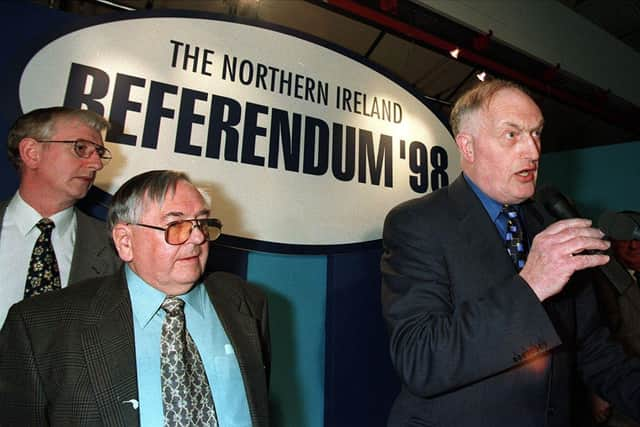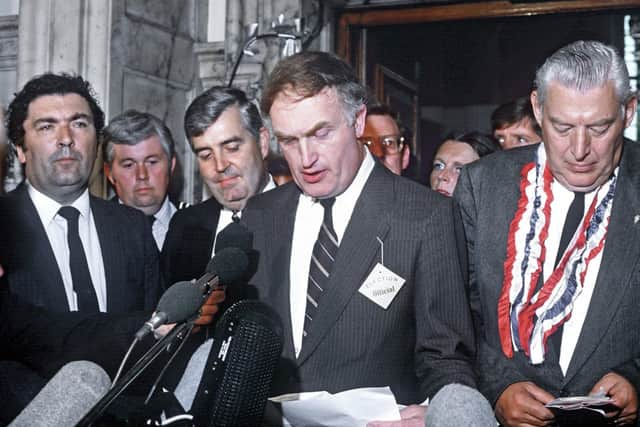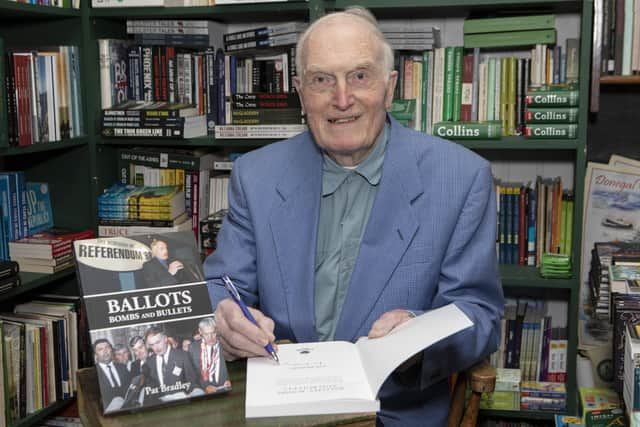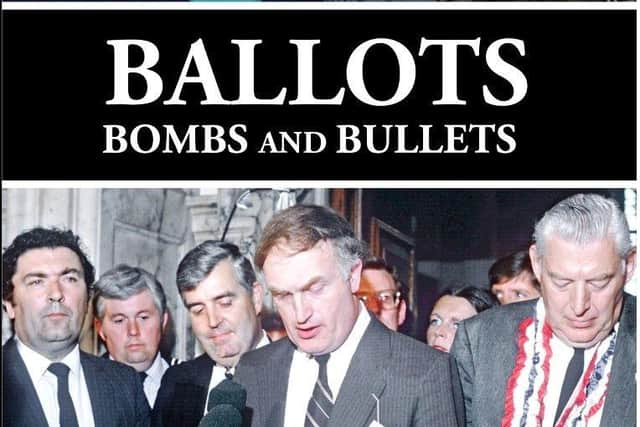Pat Bradley: the life and times of a senior public servant
and live on Freeview channel 276
After two years of often torturous multi-party talks, agreement was reached on a proposed way forward for devolution and power-sharing in Northern Ireland.
This became known as the Good Friday Agreement or The Belfast Agreement. It was decided to put it to the electorate for their endorsement, both north and south of the border.
Advertisement
Hide AdAdvertisement
Hide AdThe polling day arrangements involved a total of 1,228 polling stations at 546 locations throughout Northern Ireland, open from 07.00 hours to 22.00 hours on Friday, May 22 . The counting of the votes was to take place in the Royal Ulster Agricultural Society’s King’s Hall in Balmoral, Belfast, from 9 am the following morning.


Polling day proved to be busy but, nevertheless, relatively uneventful. A few areas suffered minor disturbances when the polls closed and ballot boxes were being taken from individual polling stations to the verification centres. The various exit polls released after 10 pm predicted a ringing endorsement of between 72% and 73% in support of the Good Friday deal.
After the close of the poll, I went to the main counting centre at the King’s Hall to check that the facility was ready for the start of the count the next morning. It became clear that I would not get to bed until well past midnight that night - and then only for a few hours, as I would have to be back at the count centre well in advance of the count commencing at 9 am. The prospect of even just a few hours sleep was a welcome one, however, as I had managed to get only limited shut-eye over the previous 48 hours.
Counting the ballots ran smoothly across the day, and at 3.10 pm I stepped onto the podium to announce the result - accompanied by my senior staff who had worked so hard throughout the process. The media scrambled to be close by, climbing over barriers in the process. I was very aware of the tension within the hall among the anxious politicians and their supporters gathered around the stage where I was to make the announcement.
Advertisement
Hide AdAdvertisement
Hide AdWhen it came to the time to announce the result, at the back of my mind there was a concern over the possibility of trouble arising in the hall between the opposing factions - some of whom would obviously be pleased with the result, with others deeply disappointed. Accordingly, I decided not to go through the standard procedure of first announcing the number of ballots, spoiled ballots etc., before giving the actual result.


Instead, I decided to proceed straight to the percentage of the votes that each of the two choices on the ballot had obtained – the figures that were widely regarded as the most important, and indeed from a unionist perspective, needed approval of at least 70 % to be acceptable. That way I felt the palpable tension would be quickly dissipated and, at the same time, the acceptability of the result would be clearly indicated.
So, upon taking the stage, I decided to dive straight in and announced: “I hereby give notice the percentage vote in the referendum was as follows: ‘Yes’ - 71.12 %…” At that point, huge cheers erupted and the hall broke into a chorus of singing, “Here we go, here we go, here we go”.
I soldiered on with the rest of the announcement but, even with the microphone, I had to shout to be heard as I announced the ‘No’ vote as 28.88 %, before continuing on with the other statistics that would normally have come before the result. The polling forecasts of a 72 or 73 % ‘Yes’ vote made in the weeks leading up to the vote had proven to be fairly accurate.
Advertisement
Hide AdAdvertisement
Hide AdGiven Northern Ireland’s ability to generate a political row out of even the most innocuous of things, the fact that the Good Friday Agreement Referendum passed without incident was, in hindsight, rather remarkable.


Successfully carrying out, as I saw it, the most important event that I was involved with, whether in Northern Ireland or in the various countries in which I operated abroad, felt like the very pinnacle of my career.
To deliver such an important, indeed crucial, event without controversy or criticism – with the task solely under my control, and without direct political oversight - did indicate to me that I had attained my goal of providing an effective electoral service that was truly independent. And I feel it also assisted in Northern Ireland’s journey along the path to a more inclusive society and, hopefully also, a more cohesive one.
Reaction to the outcome of the referendum varied predictably. British Prime Minister Tony Blair’s response was: “This is the result we have worked for and wanted. Another giant stride along the path to hope and the future.”
Advertisement
Hide AdAdvertisement
Hide AdNorthern Ireland Secretary of State Mo Mowlam was of the view: “They have chosen the future and they have voted to take control of their own destiny.”


The Office of the US President, Bill Clinton, commented that: “He was calling all the politicians in Ireland with congratulations all weekend. He is not going to walk away with just a job well done send-off. He is very serious about bolstering peace and an economic insurance policy.”
Those in the ‘No’ camp had a different perspective. The leader of the DUP claimed of the ‘Yes’ campaign: “They bribed and bullied, corrupted and tried dirty tricks and got nowhere.” Another leading ‘No’ campaigner, Robert McCartney, commented: “This referendum is the product of a massive propaganda campaign that would have been illegal in the Republic.”
The NI politicians who favoured the result took a very different attitude. For example, the leader of the SDLP, John Hume, commented: “That was a very historic act and you are telling us to lay the foundations for lasting peace and stability, and you did it in great numbers.” Sinn Féin’s Martin McGuinness advised: “What I can give is an absolute commitment that Sinn Féin will continue with a peace strategy”.
Advertisement
Hide AdAdvertisement
Hide AdDavid Trimble, leader of the Ulster Unionist Party, said: “It is a very convincing endorsement to have over 71% of the people of Northern Ireland endorse this Agreement. It is not as big a majority of unionists as I would have liked, but a clear majority of them endorsed it. We have taken an important step forward.”
David Ervine, of the fringe Progressive Unionist Party – which had strong links with some of the loyalist paramilitary groups that had previously joined in the ceasefires – commented: “It’s a brilliant result. It has to work.”
Far from marking a pause in the process, however, the heavy electoral workload continued at pace after the referendum.
The date had already been set for a new Northern Ireland Assembly to be elected on June 25, 1998 which required advertisements with instructions for how people could access postal or proxy votes to be published prior to the referendum date.
○ ‘Ballots, Bombs and Bullets’, published by Colmcille Press, is available locally from Little Acorns Bookstore (Foyle Street) and Foyle Books (Craft Village). It can also be purchased online.